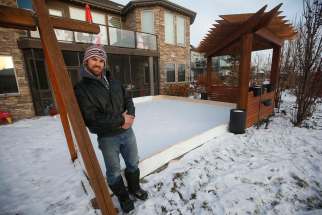Good data required for good faith
Read this article for free:
or
Already have an account? Log in here »
To continue reading, please subscribe:
Monthly Digital Subscription
$0 for the first 4 weeks*
- Enjoy unlimited reading on winnipegfreepress.com
- Read the E-Edition, our digital replica newspaper
- Access News Break, our award-winning app
- Play interactive puzzles
*No charge for 4 weeks then price increases to the regular rate of $19.00 plus GST every four weeks. Offer available to new and qualified returning subscribers only. Cancel any time.
Monthly Digital Subscription
$4.75/week*
- Enjoy unlimited reading on winnipegfreepress.com
- Read the E-Edition, our digital replica newspaper
- Access News Break, our award-winning app
- Play interactive puzzles
*Billed as $19 plus GST every four weeks. Cancel any time.
To continue reading, please subscribe:
Add Free Press access to your Brandon Sun subscription for only an additional
$1 for the first 4 weeks*
*Your next subscription payment will increase by $1.00 and you will be charged $16.99 plus GST for four weeks. After four weeks, your payment will increase to $23.99 plus GST every four weeks.
Read unlimited articles for free today:
or
Already have an account? Log in here »
Hey there, time traveller!
This article was published 23/11/2020 (1845 days ago), so information in it may no longer be current.
The Pallister government wants Manitobans to show good faith in following public health orders. However, its continued refusal to release accurate and timely information around COVID-19 cases is doing little to foster good will.
For weeks, the province has been asked for performance data on contact tracing and metrics such as the average number of close contacts per positive case.
It’s critical information. It demonstrates the extent to which public health is able to track down infected people and those they have potentially infected.
Government’s response has been incoherent, incomplete or contradictory.
That was on full display over the weekend, when Premier Brian Pallister was interviewed on CBC TV’s Rosemary Barton Live. He claimed Manitoba has eliminated its contact tracing backlog.
Not once over the past several weeks has chief provincial public health officer Dr. Brent Roussin provided any specific performance data on contact tracing. When asked repeatedly what percentage of cases and their close contacts are investigated within the benchmark timeline of 24 hours, Roussin has consistently given vague answers.
On Nov. 13, Roussin said the goal was to contact 80 per cent of cases and their contacts within 24 hours. When asked how close the province was at the time to meeting that goal, he said he didn’t have that information.
“We’re reaching everyone that we can, it’s just that we may not be reaching all of the named contacts within 24 hours,” he said. “We’re getting to all that we’re able to, that are reachable.”
Which means it could be that 20 per cent or more of close contacts are not “reachable,” are never contacted and could be unwittingly spreading the virus. In the absence of data, the public is left to guess.
When host Rosemary Barton challenged Pallister on his claim Manitoba’s measures are working, the premier accused her of “Monday morning quarterbacking” and not coming up with her own solutions to combat COVID-19.
Pallister also told CBC that Manitoba’s measures to fight COVID-19 are beginning to bear fruit because the number of contacts per case is on the decline. He said the number of close contacts has come down 25 per cent.
When host Rosemary Barton challenged Pallister on his claim Manitoba’s measures are working (given the continued rise in cases and hospitalizations), the premier accused her of “Monday morning quarterbacking” and not coming up with her own solutions to combat COVID-19.
“You’re misrepresenting the reality of the work that’s gone (into planning) by our public health officials all summer,” Pallister charged.
That’s been his pattern throughout the pandemic: provide vague and incoherent answers, and lash out when challenged.
The quest for accurate, reliable information continued Monday. Roussin was asked again for specifics on the 24-hour contact tracing benchmark.
He said the “vast majority” of cases are contacted with 24 hours, and investigations with close contacts begin at that point. He provided no data on how long it’s taking to complete those investigations. It could be days before some close contacts are tracked down; some may not be reached at all.
When asked about the average number of close contacts to positive cases, Roussin said three to four weeks ago it was “about seven.” That gradually came down to four, he said. There are some “early indications” it’s now down to two, he added. He provided no timelines.
Neither the drop from seven to four, four to two, nor seven to two supports Pallister’s claim the number of close contacts fell by 25 per cent. It’s also anybody’s guess how accurate these figures are.
When asked for official numbers from Roussin’s office, communications staff said none were available for November.
Health Minister Cameron Friesen was asked during question period Monday what percentage of positive cases and their contacts are being reached within the 24-hour benchmark. He didn’t directly answer.
“More all the time,” he said.
It’s the premier’s responsibility to ensure government is open and accountable to the public. That includes providing the public with accurate and reliable information.
Instead, government appears more interested in hiding information in an attempt to control the message.
That doesn’t serve the public well during the best of times. It could be fateful during an emergency of this magnitude.
tom.brodbeck@freepress.mb.ca

Tom has been covering Manitoba politics since the early 1990s and joined the Winnipeg Free Press news team in 2019.
Our newsroom depends on a growing audience of readers to power our journalism. If you are not a paid reader, please consider becoming a subscriber.
Our newsroom depends on its audience of readers to power our journalism. Thank you for your support.







